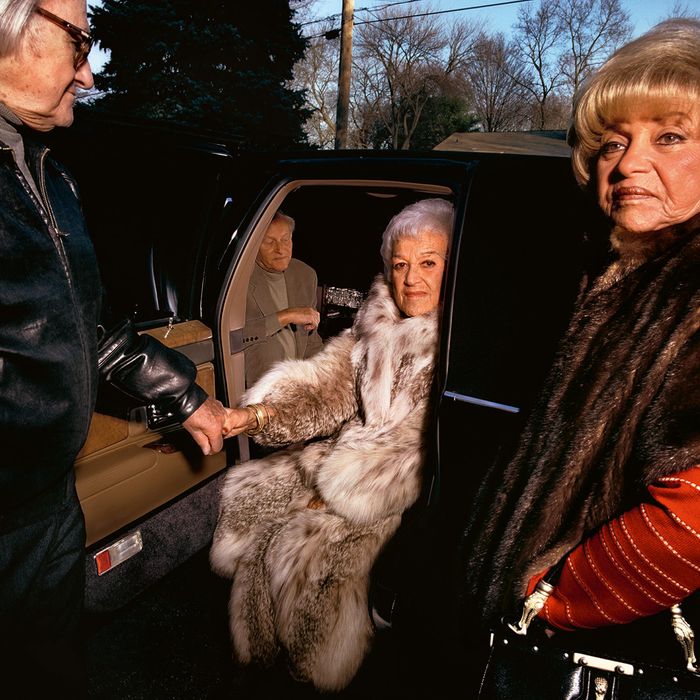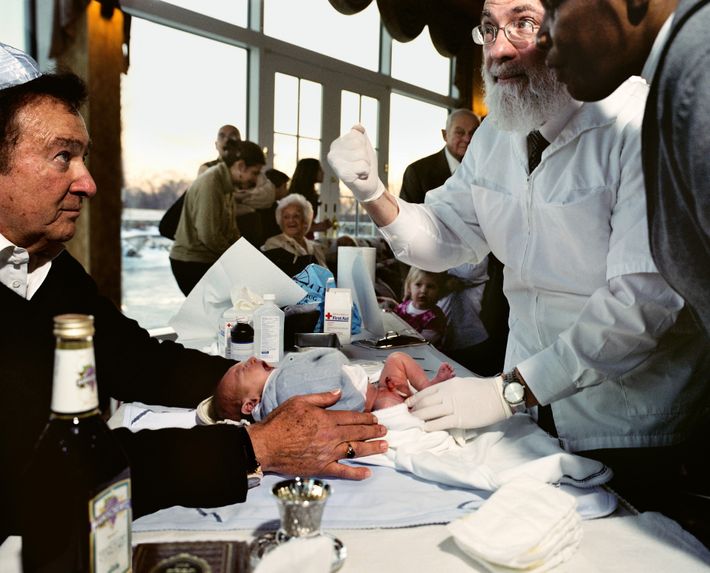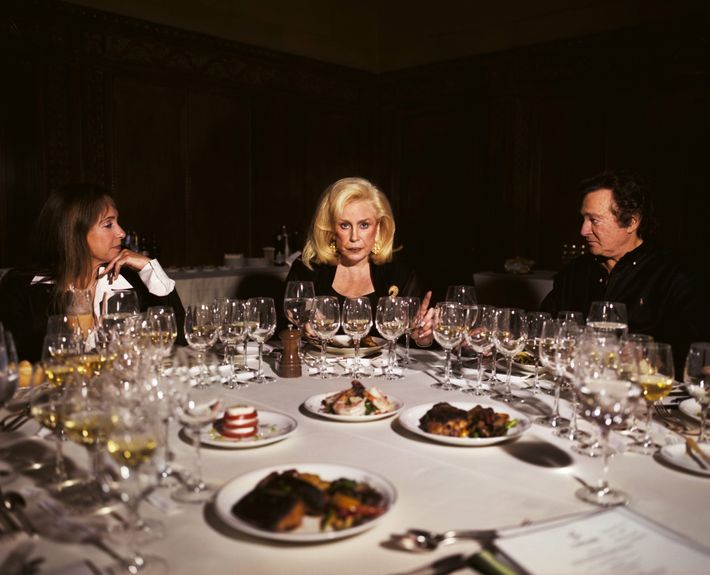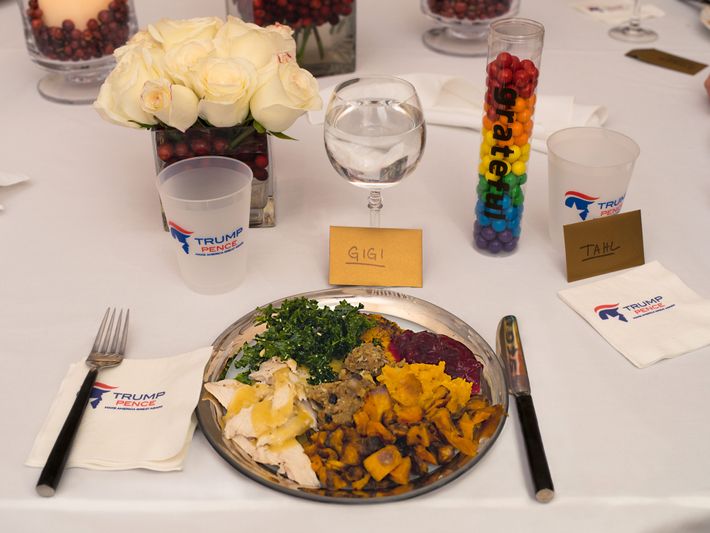
The photographer Gillian Laub grew up in a well-off New York City suburb, in a Jewish family whose defining quality was “a lot”: a lot of people, a lot of money, a lot of expression, a lot of love. As she developed her practice, photographing and building relationships with many people whose lives were harder than her own, Laub began to feel discomfort about her upbringing. It spurred her to examine her relationship to her family and the push-pull she’d felt with them throughout her life. Still, she assumed that she and her relatives stood on common moral ground. Then, in 2016, her parents — as well as her sister, brother-in-law, nephew, and many close family friends — became Trump devotees, and she felt that ground give way.
Laub had started photographing her family in 1999, beginning with a portrait of her grandfather wearing a gold chain and zebra-print bathing suit in his vegetable garden. She continued to document them through deaths, weddings, and births. During that time, she’d also created projects that examined communities in conflict — including Testimony, a collection of photographs of and stories from people living in Israel and Palestine, and Southern Rites, a photo series and film about racism in Georgia that stemmed from an assignment to photograph segregated proms in that state. So when Laub’s parents’ political views became her own private nightmare, she did what she always did: made pictures.
Starting September 24, Laub will show this body of work in a solo exhibition at the International Center of Photography called “Family Matters.” The photographs, which were made over more than two decades, are intimate, sometimes almost claustrophobic. They manage to feel both honest and staged, as if they were scenes from a provocative play. As Laub writes in her new book of the same name, released by Aperture last week, the camera functions for her as a “shield” and “mediator”; she also foregoes it at times, reproducing screenshots of group-text threads in which her relatives bombard her with Fox News talking points while she desperately tries to reason with them. In one, Laub’s father tells her to stop with the “F N Liberal hypocritical BS. Grow up.” He quickly follows this with “Luv U All.”
Laub and I sat down to talk as she installed the show at ICP, shortly after she showed the project to her parents for the first time — a terrifying moment that she documented in a video shared with Vulture, below. “There are certain people in families who are outliers, and when you’re young, that’s not a source of pride,” she said. “Trying to navigate and grow into that as you carve your path is what I was subconsciously doing. Now, making this book, I realized, Oh, that was exactly what I was doing.”
Family Matters seems to exist simultaneously from the perspective of an insider and outsider. As a fellow white American Jew raised in the New York suburbs, I have a conflicted relationship with the world I grew up in and have spent a lot of time distancing myself from it. I’m curious if that’s been your experience too.
I’ve definitely struggled with that. I think that’s also why I started photographing, because I was trying to find my place in my family. I was wrestling with so many inner conflicts. When I was younger, that manifested in depression. It sounds like a cliché, but I think photography enabled me to process certain feelings. It was kind of my passport into the world too, because I felt like there was so much more than the sheltered life I was living — I don’t mean to put it down. But I was always so curious about the world.
In the book you write about becoming aware of the contrast between the injustices faced by many of your photographic subjects and the privilege of your own life: “I had to get closer to what was making me so uncomfortable.” That struck me, because I think many people still believe there needs to be objectivity or distance in photography.
For me, it’s not just about the picture. It’s about the exchange, the relationship to whom you’re photographing. It’s about yourself. I’ve never been the type of photographer who’s like a fly on the wall. That’s not who I am. And with this particular project, I felt like it wasn’t right or fair to put my family out there without putting myself out there. I postponed the book; it was originally ready to go to press in January, but I realized I was not going to those deep, dark places.
How did you start taking pictures in the first place?
My grandfather — not the grandfather that’s pictured — gave me my first camera. I still have these Polaroids from when I was 6 years old. I would take portraits and pose people. It was immediately something I fell in love with. I didn’t realize it was something I could study and actually do until high school. I took this class called “On Creating,” which was about the relationship between photo and text. We had a Duane Michals assignment that was a huge turning point for me. I did my project on my father: I interviewed him and took pictures of him. So you could say that I started really photographing my family when I was in high school.
Was there a point at which you realized, I’m making a series about my family?
I really thought of my other projects as my art. Subconsciously, I knew there was something important there; I just didn’t know how it was going to reveal itself and if it ever would. At the very worst, I would have all these pictures, these documents from my family. There wasn’t a lot at stake for this as a project. Nicholas Nixon, I don’t know if you know that project of his, The Brown Sisters? The power of that is time, and how they changed and aged. So I always thought, Maybe that will be what’s powerful about this, after you see the cycle of life repeat itself. Maybe the meaning will reveal itself to me in the end. But I didn’t know if it was worthy of saying, This is my art.
When did you realize it was?
In 2016, when everything started revealing itself with Trump — I never anticipated that. I truly did not. But I had to photograph it. I knew it was an important time in our lives, and how I process things is I photograph them and think about them, and I keep going, over and over. In 2017, the producers of Pop-Up Magazine called me. I shared what was going on with my family, and they were like, “This would be a great story.” I was hesitant, obviously. But they told me their live events were a safe place to share stories because there would be no social-media posts, no recording. I was like, Wow, this could be really cathartic. This is an opportunity to create something out of this mess in my mind. So I did that. It was terrifying.
Afterwards, I cannot tell you the amount of people that came up to me and said, “I’m going through the exact same thing. Thank you.” It felt like there was this little support group forming. Another thing was that people kept coming up to me and saying, “God, I never thought I’d like Trump supporters. I love your family.” That was incredibly powerful, because we just kind of put people in boxes. That was when it dawned on me that this is a larger story. It touched people in a way that I think was refreshing because it wasn’t blaming or pointing fingers. There wasn’t toxicity; it wasn’t about that. It was about: How do we learn to live with this?
I’m interested in your choice to include your text messages with your family in the book. They show a level of vitriol that doesn’t otherwise come through — like when your brother-in-law accuses you of politicizing the pandemic because you shared an article from The Atlantic, and your nephew calls you “walking propaganda and fake news.”
I vacillated, and so many people had different opinions. Some people were like, “Do not include those — they take away from the art of it.” Others were like, “How can you not include them?” To me, the text messages are important because nothing can better show the facts of the fighting and how toxic it got. You can’t describe that. You have to show it. That was how we communicated for five years. I think it’s also a really interesting look at how we communicate in this day and age, and how toxic these modes of communication can be. You would never have that type of exchange if you were sitting across from each other.
Something I was thinking about while reading the Trump section is how American Jews have largely become white and how much they value that status. Trump has neo-Nazi supporters, but so many Jews still support him.
I know. I thought about that a lot. I don’t think my family sees it this way, but they tried so hard to assimilate and to be accepted into the white world. No Black people or Jewish people were allowed in other country clubs, so when Trump’s country club opens, there you go. Everyone who can pay can be a member. It’s funny because when we were at the bris at the Trump country club — this is way before the presidency, in 2007 — I remember moving all these water bottles with his face on them everywhere.
How do you balance artistic freedom with your family’s feelings?
When someone’s generous with you and allowing you to photograph them, and they really feel strongly about a photograph not being shown, I 100 percent respect that. There was a picture in the book that I thought was one of the strongest pictures, and the person in it asked me not to publish it. I lost sleep over that. I was devastated. But you know, that’s an ethical question, and my loyalty is to people. Sometimes the work has to be sacrificed for the ethics of it.
Are there certain projects or artists you were inspired by in making this work?
The photographer Larry Sultan’s work is a huge influence on me. When I saw his work — including at his retrospective — I was in awe. I loved how he used text, too, the conversations and the way he engaged his family. People are always saying about my photographs, “Oh, this is the Jewish version of Tina Barney’s work.” I did love her work. I didn’t connect to it that much because it’s a culture that’s so different than the culture I grew up in. It’s funny because I interviewed her for something, and I showed her my family work. She totally dismissed it. She liked my other work a lot more. She was like, “I’m so tired of tableau family work.” [Laughs.]
I see a through-line between Family Matters and your other work: conflict. You’re in these situations, getting to know both sides and thinking about how people coexist.
It’s more like tension, understanding cultural tensions. I do hope the work is somehow a way to build bridges. It’s a way to hear and see other points of view. My photographs and projects are in service of engaging conversations — that, to me, is the most fascinating thing. The “Southern Rites” exhibition travels through the country. It’s been in the whitest of white places, like Portland, Oregon. We did programming with the Black community there, and there were white students that were completely in denial that this is happening. Every time that exhibition is shown, it’s a reminder of how important these conversations are. When I started making that work, white people were not having these conversations. I was kind of screaming off the rooftops to white people, “Look at what is going on!” And they were like, “No, no, not here!”
When “Southern Rites” came out, I sat down with all the main characters and showed them the film. There were people who, this is the place they live in, and they saw it differently for the first time. White students who were part of the last segregated prom messaged me on Facebook saying, “I’m so sorry. Thank you.” That’s amazing. People can change; there’s room for growth. That was the biggest stamp of approval, because they were all like, “You were fair. You did right by us.” I was like, Phew, I did my job okay.
Does that signal success for you?
It does. My husband would say you’re not successful unless you piss somebody off, but that’s not my goal. I think it’s successful if it makes people think and perhaps reevaluate or open their mind in a different way. He even said, “You don’t want your family to be happy with the book, because then you didn’t make great art.” [Laughs.] I don’t agree with that.
One of my favorite photos shows your mom lying on the floor at the end of a yoga session while Trump is on TV. Can you walk me through how you made it?
This is a window into the process and how storytelling, for me, is the most important thing. What is truth? Did you recreate that? Does it make it untrue? It doesn’t matter to me. So my mom was on the floor — that happened — but I didn’t have my camera with me. I took out my iPhone. It was such a perfect moment that encapsulated everything. You couldn’t make it up. But then I had to recreate it. I had the iPhone picture, but I needed to make it a photograph. The magic of photography is that you can set up and create the tableau as much as you can, and then life happens. My mom does yoga there, and really, I couldn’t have imagined that when we turned the TV on, Trump would be talking to the housewives of America. It was like, Oh my goodness. He’s speaking to my mom. And she was saying to me, “Listen with an open mind.”
What was it like to show your parents the book?
They knew all the pictures that were going in there, but the writing was a huge component, and I made the decision to not have them read it until it was a book. I trusted that I was going to do right by them and tell a true story. There were a couple passages where I asked my sister, “Is this going to hurt Mom and Dad?” And she was like, “No, it’s the truth.” Bonnie, who’s my parents’ closest friend, read many drafts. I remember the night before she was coming over to read the final draft, I did not sleep. I was like, If she tells me I can’t publish this, I’m fucked. I was shaking when she read it, and she was crying. She said, “You can do this; I give you the green light.”
So I got two copies of the book, because I wanted my parents to sit down together and read it side by side. I wanted to film it. My mom was very nervous. I think it was good, because then she expected the worst. It was a very, very intense and emotional couple hours. We had one of the most open conversations we’ve ever had. And since they read the book, I feel like I have this relationship with them that’s much deeper and more open. It’s wild.
Do you think they understand you better now?
Yes. It’s funny, my dad doesn’t even love the pictures. I think he likes my black-and-white work better. But he told me he loves the book because it’s so honest. That’s what’s kind of amazing about my parents — it wasn’t about how good or bad they looked. Their egos weren’t part of the equation. They just respected that it was honest. That, to me, is the biggest form of love.
But it is funny — my sister, mom, and dad all looked at me like they felt bad for me: How could a politician make you so upset? How could you be so angry over someone? That’s so sad for you. My sister was like, “You’re a tortured soul.” She really looked at me like she pitied me. And that’s when you just have to laugh.










